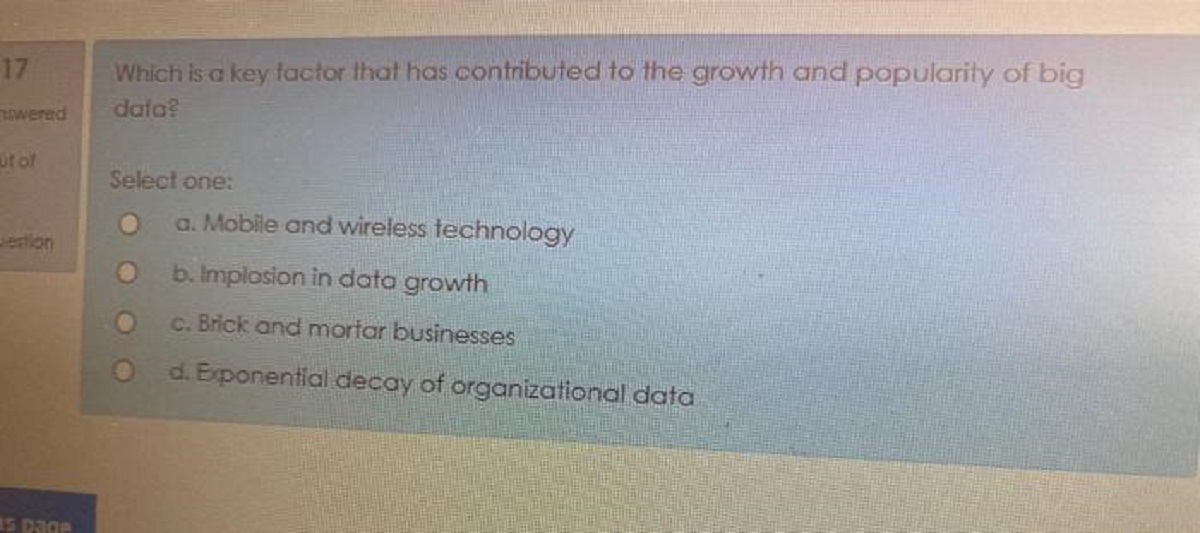The Definition of Big Data
Big Data is a term that has gained immense popularity in recent years, but what exactly does it mean? In simple terms, Big Data refers to the large volumes of structured or unstructured data that organizations generate on a daily basis. This data is characterized by its variety, velocity, and volume, and it often exceeds the processing capabilities of traditional data management tools.
The three V’s of Big Data—variety, velocity, and volume—play a crucial role in understanding its definition. Variety pertains to the diverse types of data that organizations collect, including text, images, videos, audio, and social media posts. Velocity represents the speed at which data is generated, received, and processed in real-time or near real-time. Lastly, volume refers to the enormous amount of data that is accumulated, often in the petabyte or exabyte range.
What sets Big Data apart is not just its size but also its potential for analysis and utilization. The goal is to extract valuable insights and information from this vast amount of data, which can lead to improved decision-making, strategic planning, and competitive advantage.
Big Data encompasses both internal and external data sources. Internally, organizations generate data from various systems and processes, such as customer transactions, inventory records, and employee information. Externally, data is collected from social media platforms, online forums, and external databases, among others.
Furthermore, Big Data is not limited to a single industry or sector. It is applicable across various domains, including healthcare, finance, retail, manufacturing, and telecommunications, to name a few. Every industry generates massive amounts of data, and harnessing its potential can bring about significant advancements and improvements.
While the definition of Big Data may seem straightforward, it is crucial to acknowledge that its understanding and interpretation are continually evolving. As technology progresses and data continues to grow, the scope and complexity of Big Data expand. Therefore, it is essential to stay informed about the latest developments and emerging trends in the field.
The Evolution of Big Data
The concept of Big Data has gone through a remarkable evolution over the years, driven by advancements in technology and the ever-increasing amount of data being generated. Understanding the evolution of Big Data is crucial in comprehending its significance and impact on today’s digital landscape.
The journey of Big Data began with the emergence of data storage and processing technologies in the late 20th century. Traditional databases and data warehouses were primarily designed to handle structured data, such as numerical values and text documents. However, as organizations started collecting more diverse types of data, including images, videos, and social media feeds, the limitations of these technologies became apparent.
The advent of the internet and the digital revolution paved the way for the expansion of Big Data. With the proliferation of online platforms and the rise of social media, the volume of data being generated exploded. Suddenly, organizations had to grapple with enormous amounts of unstructured data that defied traditional data management approaches.
To overcome these challenges, new technologies and frameworks were developed to handle the velocity, variety, and volume of Big Data. One of the key innovations was the development of distributed computing frameworks, such as Hadoop, which allowed for parallel processing and scalable storage of Big Data across clusters of computers.
Simultaneously, advancements in machine learning and artificial intelligence played a pivotal role in analyzing and extracting insights from Big Data. These technologies enabled organizations to uncover patterns, trends, and relationships within the vast amounts of data, resulting in more informed decision-making and actionable insights.
Another significant milestone in the evolution of Big Data was the shift towards real-time data processing. As the demand for instant insights grew, technologies like Apache Kafka and Spark Streaming emerged, enabling organizations to process and analyze streaming data in near real-time.
Additionally, the growing availability of cloud computing services and the reduction in data storage costs further accelerated the adoption of Big Data. Cloud providers offered scalable storage solutions, eliminating the need for organizations to invest heavily in infrastructure to accommodate their data growth.
Today, we find ourselves in an era where Big Data has become a fundamental asset for organizations across industries. It drives innovation, fuels advancements in various fields, and plays a crucial role in staying competitive in a data-driven world.
As the volume and complexity of data continue to increase, the evolution of Big Data is far from over. It is a continuous journey of exploring new technologies, refining methodologies, and unlocking the full potential of the data-driven future.
Increased Data Generation
One of the key factors that has contributed to the growth and popularity of Big Data is the exponential increase in data generation. In today’s interconnected world, digital technologies have become an integral part of our daily lives, generating a staggering amount of data at an unprecedented rate.
First and foremost, the rise of the internet and the widespread use of smartphones have amplified the generation of data. Every time we browse the web, send emails, post on social media, make online purchases, or interact with digital services, we leave behind a digital footprint. This constant stream of user-generated data, consisting of text, images, videos, and location information, forms a significant part of Big Data.
Furthermore, the Internet of Things (IoT) has emerged as a major contributor to the data explosion. IoT devices, ranging from smart appliances to wearable devices and industrial sensors, generate vast amounts of data, constantly monitoring and transmitting information. These connected devices collect data on everything from temperature and humidity to energy consumption and human behavior, adding to the growing pool of Big Data.
In addition to personal data, businesses have also significantly increased their data generation. With the widespread adoption of digital business processes, organizations now collect data on customer behavior, purchasing patterns, supply chain operations, and more. This data provides valuable insights for improving operational efficiency, enhancing customer experiences, and driving strategic decision-making.
Another significant contributor to increased data generation is the scientific and research community. Fields such as genomics, particle physics, astronomy, and environmental studies produce massive amounts of data from experiments, simulations, and observations. Analyzing this data helps scientists gain a deeper understanding of complex phenomena and make scientific breakthroughs.
The growth of social media platforms and the vast amount of user-generated content they host cannot be overlooked. Every minute, millions of social media posts, photos, and videos are shared, creating a wealth of data that can offer valuable insights into consumer trends, sentiment analysis, and brand engagements.
The increased data generation also extends to government agencies and public institutions. Data is collected for purposes such as census and demographic studies, urban planning, healthcare management, and national security. The aggregation and analysis of this data have the potential to drive policy decisions and improve public services.
As the world becomes more digitized and interconnected, the proliferation of data generation shows no signs of slowing down. With the advent of technologies like 5G, artificial intelligence, and edge computing, the data landscape is expected to expand even further. It is crucial for organizations and individuals alike to leverage this wealth of data responsibly and ethically to derive meaningful insights and drive positive change.
Advancements in Technology
The growth and popularity of Big Data would not have been possible without the advancements in technology that have revolutionized the way we collect, store, and analyze data. These advancements have played a crucial role in handling the sheer volume, velocity, and variety of Big Data, making it a valuable asset in today’s digital-driven world.
One of the key technological advancements that has paved the way for Big Data is the development of distributed computing frameworks. Technologies like Hadoop, Spark, and other similar frameworks allow for parallel processing and distributed storage of data across multiple machines or clusters. This enables organizations to handle vast amounts of data, breaking it down into smaller, manageable chunks, and processing it faster than ever before.
Furthermore, advancements in storage technologies have significantly contributed to the growth of Big Data. Traditional storage methods, such as hard disk drives (HDDs), have been supplemented by solid-state drives (SSDs) and cloud storage solutions. SSDs offer faster access to data, improving the speed of data retrieval and analysis. Cloud storage provides scalable and flexible storage options, eliminating the need for organizations to invest in expensive physical infrastructure.
The evolution of data processing tools and algorithms has also played a significant role in the success of Big Data. Machine learning and artificial intelligence techniques have become indispensable in analyzing and deriving insights from vast amounts of data. These technologies can identify patterns, correlations, and anomalies that may not be readily apparent to human analysts, enabling organizations to make data-driven decisions and drive innovation.
In recent years, the rise of real-time data processing has been a game-changer for many businesses across industries. Technologies like Apache Kafka, Apache Flink, and others enable organizations to process streaming data in real-time, allowing for instant insights and faster decision-making. Real-time data processing has applications in various fields, such as fraud detection, predictive maintenance, and personalized customer experiences.
Advancements in data visualization tools have also played a crucial role in making Big Data more accessible and understandable. Visualization tools allow users to transform complex datasets into visually appealing and interactive charts, graphs, and dashboards. This enables stakeholders to explore data intuitively, identify trends, and communicate insights effectively.
Lastly, the emergence of edge computing has become a significant development in the world of Big Data. Edge computing brings computing power closer to where data is generated or consumed, reducing latency and enabling real-time analysis at the edge of the network. This is particularly valuable in scenarios where real-time decision-making is critical, such as autonomous vehicles and industrial IoT applications.
As technology continues to advance at a rapid pace, the possibilities for Big Data are endless. Innovations in areas like quantum computing, natural language processing, and data privacy and security will shape the future of Big Data, unlocking new opportunities and challenges.
Reduction in Data Storage Costs
One of the key factors that has contributed to the growth and popularity of Big Data is the significant reduction in data storage costs. In the past, storing and managing large volumes of data was a costly endeavor, often limiting the ability of organizations to capitalize on the potential of their data. However, with advancements in technology and the emergence of new storage solutions, the cost of data storage has plummeted, making it more accessible and affordable for businesses of all sizes.
Traditionally, storing and managing data required organizations to invest in on-premises storage infrastructure, including servers, hard drives, and backup systems. This capital expenditure was often a barrier to entry for many organizations, especially small and medium-sized businesses with limited resources. However, the advent of cloud computing has revolutionized the way data is stored and accessed.
Cloud storage providers offer scalable and flexible storage solutions, allowing organizations to pay for the storage capacity they need, without the upfront costs of physical infrastructure. This pay-as-you-go model has made data storage more cost-effective, as organizations can scale up or down based on their data storage requirements. Furthermore, cloud storage providers offer redundancy and data backup options, ensuring data durability and availability.
In addition to cloud-based solutions, the advancement of solid-state drives (SSDs) has significantly contributed to the reduction in data storage costs. SSDs offer faster data access and retrieval compared to traditional hard disk drives (HDDs). While SSDs initially had a higher price point than HDDs, the cost has been decreasing rapidly, making them a more affordable storage option for organizations.
Moreover, the emergence of data compression and deduplication technologies has helped organizations optimize their data storage space. These technologies eliminate redundant data and compress data, reducing the amount of storage required. By minimizing data duplication and employing efficient compression algorithms, organizations can reduce their data storage costs without sacrificing data integrity or accessibility.
Another cost-saving factor is the ability to choose between different storage tiers based on data access frequency and latency requirements. Cloud storage providers typically offer different storage classes, ranging from high-performance storage for frequently accessed data to lower-cost archival storage for infrequently accessed data. This tiered storage approach allows organizations to store their data cost-effectively while ensuring that it is accessible when needed.
Furthermore, open-source storage solutions and software-defined storage have emerged as viable alternatives to costly proprietary storage systems. These solutions leverage commodity hardware and open-source software to create highly scalable and cost-effective storage infrastructures. By utilizing open-source technologies and commodity hardware, organizations can significantly reduce their data storage costs, without compromising on performance or scalability.
The reduction in data storage costs has democratized access to data storage, enabling organizations of all sizes to leverage Big Data analytics and storage capabilities. The accessibility and affordability of data storage solutions have played a pivotal role in the widespread adoption of Big Data, empowering businesses to make data-driven decisions and gain a competitive edge.
The Rise of Social Media and Online Platforms
The rise of social media and online platforms has been a significant factor in the growth and popularity of Big Data. These platforms have revolutionized the way people connect, communicate, and share information, resulting in an explosion of user-generated data that forms a substantial part of the Big Data ecosystem.
Social media platforms, such as Facebook, Twitter, Instagram, and LinkedIn, have transformed the way people interact with one another, creating vast networks of interconnected individuals. These platforms facilitate the sharing of thoughts, opinions, images, videos, and other forms of content, generating an enormous amount of data on a daily basis.
Every post, comment, like, share, and follow generates valuable data that can be analyzed for various purposes. This data provides insights into consumer behavior, preferences, trends, sentiment analysis, and brand engagements. Businesses can leverage this information to understand their target audience better, tailor their marketing strategies, and improve customer experiences.
In addition to social media platforms, the proliferation of online platforms, such as e-commerce websites, video sharing platforms, and online forums, has contributed to the growing volume of Big Data. These platforms generate vast amounts of user data through transactions, product reviews, user-generated content, and customer interactions.
E-commerce platforms, like Amazon and Alibaba, collect data on customer browsing behavior, purchase history, and preferences. This data is valuable for personalized marketing, product recommendations, and improving the overall online shopping experience.
Video sharing platforms, such as YouTube and TikTok, generate enormous amounts of user-generated content, including videos, comments, and engagement metrics. This data offers insights into viewer preferences, content trends, and audience engagement, enabling marketers and content creators to optimize their strategies and drive engagement.
Online forums and discussion boards, like Reddit and Quora, provide a platform for users to share knowledge, ask questions, and engage in discussions. The data generated in these platforms can be analyzed to identify emerging topics, understand user sentiment, and gain valuable insights into various industries and subjects.
The rise of social media and online platforms has also facilitated the collection of real-time data. With users constantly sharing updates and engaging with content in real-time, organizations can capture and analyze this data in near real-time, allowing for timely decision-making and immediate response to market trends.
Furthermore, social media and online platforms have become powerful tools for social and political analysis. Researchers, journalists, and policymakers can analyze trends, sentiments, and discussions on these platforms to gain insights into public opinion, societal issues, and political movements.
The data generated from social media and online platforms presents both challenges and opportunities. On one hand, organizations must handle and protect user data responsibly, ensuring privacy and security. On the other hand, organizations can leverage this data to enhance products and services, personalize experiences, and gain deep insights into consumer behavior.
The rise of social media and online platforms has transformed the way we communicate and share information, creating a wealth of user-generated data that forms a significant part of Big Data. Leveraging this data effectively can unlock valuable insights, drive innovation, and shape strategies across various industries and domains.
The Importance of Data-Driven Decision Making
Data-driven decision making has become a critical aspect of modern business strategies, as organizations recognize the significant advantages it offers in terms of efficiency, competitiveness, and innovation. Data-driven decision making involves using data analysis and insights to guide and support the decision-making process, rather than relying on intuition or guesswork.
One of the key benefits of data-driven decision making is the ability to make informed and evidence-based decisions. By analyzing large volumes of data, organizations can uncover patterns, trends, and correlations that may not be apparent through traditional decision-making approaches. This insight allows for a deeper understanding of the market, customer behavior, and operational processes.
Data-driven decision making also enhances the accuracy and reliability of decision outcomes. By relying on data analysis rather than subjective opinions or biases, organizations can minimize the risks associated with human error or cognitive biases. By basing decisions on facts and evidence, organizations can increase the likelihood of successful outcomes and avoid costly mistakes.
Moreover, data-driven decision making enables organizations to identify new opportunities and capitalize on emerging trends. By analyzing market data, customer feedback, and industry insights, organizations can spot potential gaps in the market, understand changing customer preferences, and develop innovative products or services. This proactive approach allows organizations to stay ahead of the competition and create a competitive advantage.
Data-driven decision making also promotes agility and adaptability. In today’s fast-paced and dynamic business environment, organizations need to respond quickly to changing market conditions and customer demands. By continuously analyzing data, organizations can identify shifts and trends in real-time and make timely adjustments to their strategies and operations.
Furthermore, data-driven decision making fosters a culture of accountability and transparency within organizations. By relying on data and evidence, decisions can be objectively evaluated, and the rationale behind them can be clearly communicated. This transparency builds trust among stakeholders and allows for a collaborative decision-making process.
Another advantage of data-driven decision making is the ability to measure and track the effectiveness of decisions. By setting measurable goals and collecting relevant data, organizations can assess the impact of their decisions and refine their approaches accordingly. This iterative process of data-driven decision making enables organizations to continuously improve their strategies and achieve better outcomes over time.
Data-driven decision making is not limited to large corporations or specific industries. It has become increasingly accessible and applicable to organizations of all sizes and across various sectors. The right tools, technologies, and expertise allow organizations to harness the power of big data and leverage it to drive decision-making processes effectively.
In summary, data-driven decision making is a crucial element of successful business strategies in today’s data-driven world. By leveraging data analysis and insights, organizations can make informed decisions, increase accuracy, identify opportunities, foster agility, promote accountability, and continuously improve their performance.
The Discoveries and Insights Drawn from Big Data
Big Data has ushered in a new era of discovery and insight generation. The vast amount of data available today provides organizations with unprecedented opportunities to uncover patterns, correlations, and valuable insights that were previously hidden. These discoveries and insights drawn from Big Data have the potential to revolutionize industries, drive innovation, and inform strategic decision making.
One of the key discoveries made possible by Big Data is the ability to identify trends and forecast future outcomes. By analyzing large volumes of data over time, organizations can detect patterns and predict market trends, consumer behavior, and customer preferences. These insights enable organizations to make data-driven forecasts and predictions, helping them stay ahead of the competition and anticipate future demands.
Big Data also allows organizations to gain a deeper understanding of their target audience. By analyzing demographic data, online behavior, and social media interactions, organizations can segment their customer base more effectively, personalize marketing campaigns, and tailor their products or services to meet specific customer needs. These insights lead to improved customer satisfaction, increased customer loyalty, and more effective customer acquisition strategies.
Furthermore, Big Data enables organizations to optimize their operations and improve efficiency. By analyzing data from various sources, including supply chain systems, production logs, and customer feedback, organizations can identify bottlenecks, streamline processes, and enhance productivity. These insights help organizations make data-driven decisions on resource allocation, operational improvements, and cost reduction.
Big Data has also allowed for significant advancements in healthcare and medicine. By analyzing large-scale patient data, genomics data, and clinical trial results, medical researchers can identify new treatment options, predict disease outcomes, and develop personalized medicine. These insights enable healthcare professionals to provide better diagnoses, improve treatment plans, and enhance patient outcomes.
Moreover, Big Data has revolutionized the field of marketing and advertising. By analyzing customer data, online behavior, and social media sentiments, organizations can create targeted and personalized marketing campaigns. These insights allow organizations to reach the right audience at the right time, resulting in better engagement, higher conversion rates, and improved return on investment.
Big Data also plays a crucial role in the field of scientific research. Researchers can analyze large datasets, such as climatic data, astronomical data, or particle physics data, to gain a deeper understanding of complex phenomena. These insights can lead to groundbreaking discoveries, advancements in scientific knowledge, and the development of new technologies.
Furthermore, Big Data has enabled organizations to enhance cybersecurity and reduce the risk of cyber threats. By analyzing network traffic data, user behavior patterns, and system logs, organizations can detect anomalies, identify potential security breaches, and implement proactive measures to protect their systems and data.
The discoveries and insights drawn from Big Data are not limited to specific industries but can have a transformative impact on various sectors. As organizations continue to harness the power of Big Data and develop sophisticated data analytics techniques, the potential for new discoveries and insights is boundless.
The Impact of Big Data on Various Industries
Big Data has revolutionized various industries, transforming the way organizations operate, make decisions, and deliver products and services. The impact of Big Data can be seen across sectors, from healthcare and finance to retail and manufacturing. Let’s explore the significant impact Big Data has had on these industries and more.
Healthcare: Big Data has the potential to enhance patient care, improve medical research, and enable personalized medicine. Through the analysis of large-scale patient data, genomics data, and clinical trial results, healthcare professionals can make data-driven decisions for better diagnoses, treatment plans, and patient outcomes. Big Data also allows for real-time monitoring of patients’ vital signs, enabling timely interventions and personalized healthcare management.
Finance: Big Data has transformed the financial industry by enabling more accurate risk assessments, fraud detection, and advanced algorithmic trading. By analyzing vast amounts of financial and market data, organizations can make better investment decisions, detect anomalies, and create customized financial products and services for their clients. Big Data also plays a critical role in credit scoring, facilitating faster and more accurate evaluations of creditworthiness.
Retail: Big Data has revolutionized the retail industry by enabling targeted marketing, inventory optimization, and personalized customer experiences. By analyzing customer data, purchasing patterns, and online behavior, retailers can tailor marketing campaigns, optimize pricing and promotions, and personalize product recommendations. Big Data also allows retailers to forecast demand accurately, manage inventory more efficiently, and reduce out-of-stock situations.
Manufacturing: Big Data has transformed the manufacturing industry through improved supply chain management, predictive maintenance, and quality optimization. By analyzing data from sensors, production logs, and customer feedback, manufacturers can optimize their operations, identify bottlenecks, and detect potential equipment failures before they happen. Big Data allows manufacturers to implement predictive maintenance strategies, reduce downtime, and improve overall operational efficiency.
Transportation and Logistics: Big Data has had a significant impact on the transportation and logistics industry by optimizing routes, enhancing fleet management, and improving customer experiences. By analyzing transport data, weather conditions, and traffic patterns, organizations can optimize delivery routes, reduce fuel consumption, and minimize delivery time. Big Data also allows for better fleet management, enabling efficient vehicle maintenance and reducing operational costs.
Energy: Big Data is transforming the energy industry by enabling smart grid management, energy optimization, and renewable energy integration. By analyzing data from smart meters, weather forecasts, and energy consumption patterns, utilities can optimize energy distribution, reduce wastage, and identify areas for energy-saving initiatives. Big Data also facilitates the integration of renewable energy sources, such as solar and wind, by optimizing their generation and storage capabilities.
Media and Entertainment: Big Data has significantly impacted the media and entertainment industry by personalizing content recommendations, improving audience engagement, and enhancing content production. By analyzing user behavior, viewing patterns, and social media sentiments, organizations can personalize content suggestions, tailor advertising campaigns, and optimize content creation based on audience preferences. Big Data also enables media companies to gain insights into audience sentiment and preferences, helping them create engaging and relevant content.
Human Resources: Big Data has transformed HR processes, enabling organizations to make data-driven decisions in talent management, employee engagement, and workforce planning. By analyzing employee data, performance metrics, and sentiment analysis, organizations can identify high-performing employees, create targeted training programs, and improve employee satisfaction. Big Data also allows organizations to forecast future talent needs, optimize recruitment processes, and reduce employee turnover.
Education: Big Data is transforming education by enabling personalized learning experiences, improving student performance, and optimizing educational resources. By analyzing student data, learning styles, and academic performance, educators can tailor learning materials, identify at-risk students, and implement targeted interventions. Big Data also helps educational institutions optimize resource allocation, identify areas for curriculum improvement, and develop data-driven strategies for continuous improvement.
The impact of Big Data on various industries is immense and continues to evolve. As organizations harness the power of Big Data and develop advanced analytics capabilities, they gain a competitive advantage, drive innovation, and deliver enhanced products and services to their customers.
The Future of Big Data
The future of Big Data is promising, with ongoing advancements in technology and growing global connectivity. As the volume, velocity, and variety of data continue to increase, the potential for extracting valuable insights and driving innovation becomes even more significant. Here are some key trends and developments that are shaping the future of Big Data.
Artificial Intelligence (AI) and Machine Learning (ML): AI and ML technologies are evolving rapidly, and they play a crucial role in unlocking the full potential of Big Data. These technologies enable organizations to analyze vast amounts of data, uncover patterns, and derive actionable insights. As AI and ML capabilities continue to advance, we can expect more sophisticated algorithms that can handle complex analytics tasks and provide more accurate predictions and recommendations.
Edge Computing: The rise of edge computing is poised to have a significant impact on Big Data. By bringing computation and analytics closer to the data source, edge computing reduces latency and enables real-time data analysis. This is crucial for applications that require immediate processing, such as autonomous vehicles, industrial IoT, and real-time analytics in healthcare. With the emergence of 5G networks, edge computing is expected to become even more prevalent.
Data Privacy and Governance: As the value and sensitivity of data increase, data privacy and governance become paramount. Organizations are increasingly facing regulations and concerns regarding data privacy and security. In response, there will be a greater focus on implementing robust data governance frameworks, ensuring compliance with regulations, and adopting technologies like differential privacy to protect individual privacy while still extracting insights from data.
Big Data in Healthcare: In the healthcare industry, Big Data will continue to pave the way for advancements in personalized medicine, disease prevention, and healthcare delivery. The integration of electronic health records, genomics data, wearable devices, and real-time monitoring will provide healthcare professionals with a comprehensive view of patients’ health and enable personalized treatment plans. The application of AI and ML in medical research will also lead to breakthroughs in drug discovery and precision medicine.
Ethical and Responsible Data Use: As Big Data grows, there will be an increased focus on ethical and responsible data use. Organizations will need to prioritize transparency, informed consent, and data anonymization to build trust with consumers. Responsible use of data will involve maintaining data accuracy, avoiding bias, and ensuring fairness in decision making. This shift towards ethical data practices will be crucial in maintaining public trust and ensuring the responsible use of Big Data.
Data Visualization and Storytelling: The ability to effectively communicate insights and stories through data visualization will continue to gain importance. As Big Data becomes more complex, organizations will rely on visualizations and storytelling techniques to present data in a clear and compelling manner. Data visualization tools will continue to evolve, providing more interactive and intuitive ways to analyze and present data insights.
Data Collaboration: Collaboration and data sharing between organizations will become increasingly important. As organizations recognize the benefits of combining data from various sources, there will be a greater emphasis on data collaboration and interoperability. Data sharing partnerships and platforms will emerge, enabling organizations to extract more comprehensive insights and drive collective innovation.
The future of Big Data holds immense potential for organizations across industries. As technology continues to advance, the ability to harness the power of Big Data and derive valuable insights will be a key differentiator for businesses. However, with this power comes the responsibility to handle data ethically, ensuring privacy, security, and transparency. As the Big Data landscape evolves, organizations that navigate these challenges and leverage data effectively will be positioned for success in the digital age.

























